Last Updated on by Mitch Rezman
I was at my first AFA convention last week. It was the 41st annual convention of the American Federation of Agriculture. You’re familiar with the organization – right? Or not so much.
Members of the AFA are the unsung heroes helping solve legal, behavioral and nutritional problems if it has anything to do with an exotic bird or parrot
Earlier this year we talked about how the government wants to outlaw your bird. The folks at the AFA are the people standing up to the government protecting our pet birds. The list of speakers at this year’s convention read like a Who’s Who of the bird world
We would’ve loved to have taken four days off and participated in all the events and listen to all the speakers but for us much like most of you, time is at a premium.
I took in a lot of information but one of the speakers, Josee Birmingham from HARI was particularly engaging.
To clarify – HARI stands for the Hagen Avicultural Research Institute. One of our best selling bird foods is Hagen.
Reading about bird food you are about to buy or have been buying, the bird food on our website or even reading the back of a bag while shopping in our Birdie Boutique you’ll get the same information that most every bird food manufacturer provide – ingredients and serving directions. Something about the company is like the “how this bird food came to be” story.
But if you want to really know about Hagen bird food and if you’ve ever said to yourself aloud “I’d really like a lot of birds, that way I’ll learn so much,” talk to Josee.
She lives at the HARI facility with her husband, two sons, and 500 FREAKIN’ BIRDS! The facility has been a hostel to these roughly 500 birds for almost 3 decades. Birds come, birds go, with their long-range purpose as to act as the ultimate quality control inspectors for Hagen bird food
Birds are fed the same batch of say Tropican pellets for 90 days.
The birds are weighed and tested on a regular basis and their poop is analyzed. Nothing is untested, nothing is wasted.
Would you like to know what they found out about raising parrots? Visit the avian care category on the HARI website.
In that, I’d love to be able to provide you with everything you need to know about raising exotic birds in 2000 words or less – every week I can’t. So much like I do with many projects I break things down into small manageable segments.
Let’s talk about sunlight, shall we? One of the more consistent themes on this blog is full-spectrum lighting and vitamin D production.
Flocks of bird owners spend hours doing research about birds and lighting.
We ship a boatload of full-spectrum lighting. We also get a lot of questions about full-spectrum lighting from people usually armed with a bunch of information from the I-N-T-E-R-N-E-T!
We are constantly asked what is the CRI (color rendition index) of a certain full spectrum bulb or what’s the Kelvin temperature of the bulb?
5000 degrees Kelvin is equivalent to sunlight but not fully unless it has an adequate CRI but I never get the two questions asked together – darn Internet.
Further, I keep seeking an answer (science geek wannabe that I am) to the question “what about the distance from the light source?
Will the reduction of Lumens due to increasing distances from the light source reduce the ability of the light source to help a bird’s body produce vitamin D?”
Micro science lesson: there is a property of light called the “inverse square law” – if you’re an old guy like me you learned it (because you needed to) when you were shooting your SLR camera with f-i-l-m. Does anyone remember “f-stops” & “shutter speeds?”
The inverse square law is a general principle of light, sound, gravity, etc. in which the intensity of energy coming from a given point varies inversely with the square of the distance from that point (Ex: as the distance from a point increases from 1 to 2 to 3 units, the intensity will correspondingly decrease from 1 to 1/4 to 1/9)
Translation: your bird can be getting a thousand lumens of light from that fancy schmancy full spectrum lighting set up on top of the cage when your bird is on its sleeping perch, which is presumably the highest perch in the cage.
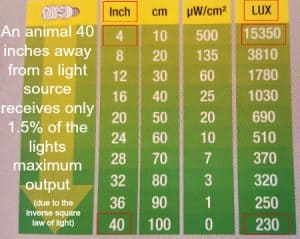
Assuming this is a large parrot in a six-foot-tall bird cage and the bird now craves that piece of an Avi cake it dropped 2 days ago now wedged in the grate on the floor of the cage.
The big bird climbs down to the bottom of the cage and because you’re a great caged bird keeper there are all sorts of foraging and enrichment opportunities strategically placed towards and on the bottom of the cage.
The bird spends an hour down there foraging, eating, and preening – now 6 feet away from the light source meaning he or she is currently getting about 125 lumens of light – from your 1000 lumen bulb – the inverse square law of light in action.
Does anyone really even know what a lumen is or does? For the record, a lumen is the “SI unit of luminous flux, equal to the amount of light emitted per second in a unit solid angle of one steradian from a uniform source of one candela”
So that was helpful huh? Still don’t know what they are but somehow you still think you need them – because the Internet said so, or was it Facebook?
BTW for you younguns – Photographic film is a strip or sheet of transparent plastic film base coated on one side with a gelatin emulsion containing microscopically small light-sensitive silver halide crystals.
The sizes and other characteristics of the crystals determine the sensitivity, contrast and resolution of the film.
The emulsion will gradually darken if left exposed to light, but the process is too slow and incomplete to be of any practical use.
Instead, very short exposure to the image formed by a camera lens is used to produce only a very slight chemical change, proportional to the amount of light <<think inverse square law) – absorbed by each crystal. This creates an invisible latent image in the emulsion, which can be chemically developed into a visible photograph.
Or you can use your smartphone – end science lesson.
It seems of late that every concerned pet bird keeper is yakking about Kelvin, lumens, UVA’s, UVB’s, fluorescent tubes, incandescent lights and LED lighting while chasing the production of vitamin D in their bird, something they’re not even sure the gosh darn bird is deficient in!
Strange things happen when you’re a caregiver to 500 birds.
You end up learning a lot and you become interesting in other people and organizations like universities.
Josee, in conjunction with a local university, decided to test how much UVA/UVB lighting it takes to synthesize vitamin D3 in birds.
Using things like science (which I never argue with) to track precise amounts of UVA and UVB light and then drawing blood on a regular basis from birds who were exposed to these precise amounts of light.
The blood was sent to the University which has machines that only universities have that can detect not just vitamin D but vitamin D3 (25-dihydroxycholecalciferol) which is what everybody is seeking.
News flash:
Although full-spectrum lighting with UVA and UVB has shown to be effective in vitamin D production for reptiles (think of a bearded dragon bathing under a basking lamp on a rock for six straight hours 1 foot away) LIGHT HAS ZERO EFFECT ON THE PRODUCTION OF D3 IN BIRDS!
Let me say that again
LIGHT HAS ZERO EFFECT ON THE PRODUCTION OF D3 IN BIRDS!
Researchers are actually finding that too much UVA and UVB can actually burn the retinas in birds and are now recommending no more than 5 hours of light containing UVA and UVB.
Observe birds in the wild – they spend much of their time in the shade!
Don’t get me wrong – light is not inherently bad. Patrick R. Thrush talks about light in the NCS Journal July/August 1999, Vol. XVI, No. 4. He succinctly notes that “The vast majority of the lighting we use, bears little similarity to the light of the sun.”
He goes on to say “Birds have a highly developed sense of light. Humans perceive light through our eyes.
Our feathered friends have an additional way of interpreting light conditions, a special gland which is on top and behind a birds-eye, the pineal gland.
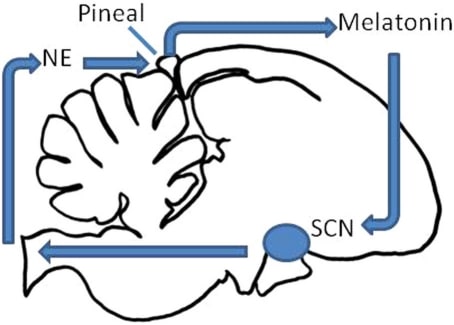
The pineal gland is photoreceptive in all non-mammalian vertebrates, but not in mammals.
The only non-visual photoreceptors in mammals are intrinsically photosensitive ganglion cells in the retina. The parapineal and similar pineal-associated structures are only found in non-mammalian vertebrates.
(The quail’s light-sensing neurons are tucked within the paraventricular organ.)
The iris is intrinsically photo-receptive in non-mammalian vertebrates and perhaps in some mammals.
The locations of non-visual photoreceptors (shown in yellow) in the deep brain varies among the non-mammalian vertebrates. (Graphic: Current Biology, I. Provencio)
“The second consideration of sunlight concerns the health of the animal.
Ultraviolet radiation works with the natural immune system, strengthening it to protect the bird against pathogens.”
Mr. Thrush eloquently lays out the premise that sunlight has four unique effects on the life of a bird.
it regulates the metabolic clock and gives the perception of the season
-
its full range is almost completely used for vision
-
it assists in the health and sense of well-being of the animal
-
it provides necessary vitamin support for bone and physical development.
This brings us full circle to that “sunlight” thing. You may consider yourself the Martin Scorsese of bird full spectrum lighting but without drawing blood from your caged birds and having said blood analyzed, you’ll never really know if your full spectrum lighting strategy is effective and meeting your vitamin synthesis goals.
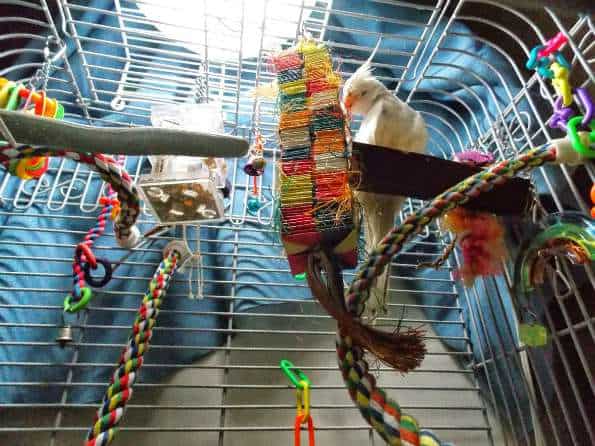
Here’s our cockatiel Popcorn with our economy full spectrum bulb
The bulb has no UVA/UVB – the cockatiel has no vitamin D deficiency – vet tested
we just make sure she eats right – go figure
This is where we stop you from overthinking how best to provide an environment for your caged birds.
Give them light and give them love but don’t think for a moment you can give them what they intuitively expect from mother nature.
Written by Mitch Rezman
And Approved by Catherine Tobsing
Author Profile
Latest entries
 The Traveling BirdJune 26, 2025Can You Name 5 Parrot Species That Are Living Wild in the USA?
The Traveling BirdJune 26, 2025Can You Name 5 Parrot Species That Are Living Wild in the USA? Bird BehaviorJune 26, 2025How is it Parrots Are Problem Solvers Social Animals and Even Use Tools?
Bird BehaviorJune 26, 2025How is it Parrots Are Problem Solvers Social Animals and Even Use Tools? Bird & Parrot AnatomyJune 25, 2025How a Tiny Chemical Modification Makes Parrots Nature’s Living Paintings
Bird & Parrot AnatomyJune 25, 2025How a Tiny Chemical Modification Makes Parrots Nature’s Living Paintings PigeonsJune 20, 2025How Do Parrots Thrive in Cities Outside Their Native Habitats?
PigeonsJune 20, 2025How Do Parrots Thrive in Cities Outside Their Native Habitats?

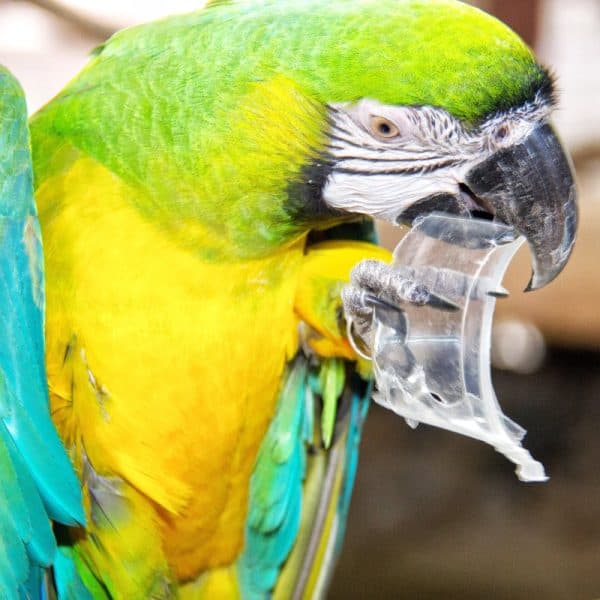
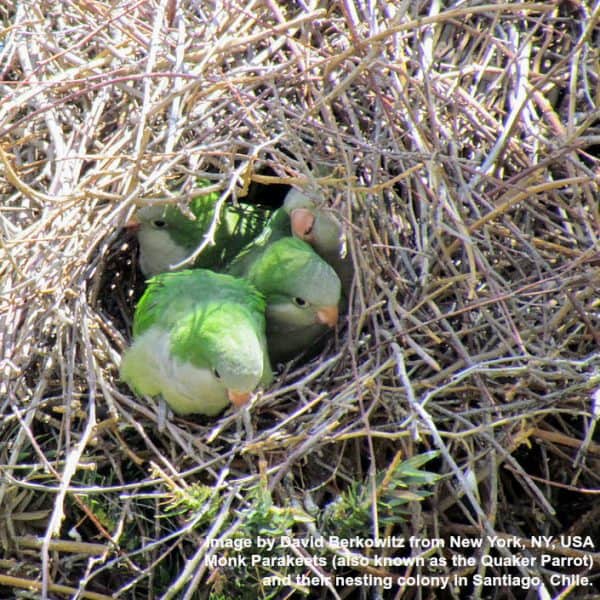


Aleron
1 Feb 2017Where can we read the actual research article and papers about the UVA not helping with d-vit production? Any links to this University you talk about here? You don’t even give the name city name and the name to to this university?! Where is the prof?
WindyCityParrot
14 Oct 2017neither does anyone else Aleron https://windycityparrot.com/blog/2017/10/14/6832/
WindyCityParrot
17 Oct 2017where the proof that it does work Aleron – Not one veterinarian or PHD has produces a stitch of evidence that artificial light in a home helps synthesize vitamin D
JewelsinMo
13 Feb 2017So I just purchased a little get from you, but now I’m confused! To light or not to light, and if so – how long?? The stand is too short to reach the top of the cage and my CAG is out and about all day. Am I wasting my time with this lamp on 12 hrs? Confusion reigns.
WindyCityParrot
13 Feb 2017whichl amp JewelsinMo?
JewelsinMo
13 Feb 2017It is the Full Spectrum Sunlite Bird Cage floor lamp – $69. Just not exactly sure how to use it. Worried when I read about burning retinas, etc.
Nancy Drew
4 Oct 2017Keep the avian zoo sun lamp about thirty inches away for the first 150 hours of the bulbs life when uv enittence is really high.
After 150 hours burn time keep it 20 inches above cage. Don’t place it sideways it will cause retinal damage as bird will stare into the light source. I use the lamp only two hours per day. The lamp is stated to last for 12 months.
WindyCityParrot
17 Oct 2017At thirty inches – the lamp has no value for the bird Nancy
Nancy Drew
4 Oct 2017Keep the avian zoo sun lamp about thirty inches away for the first 150 hours of the bulbs life when uv enittence is really high.
After 150 hours burn time keep it 20 inches above cage. Don’t place it sideways it will cause retinal damage as bird will stare into the light source. I use the lamp only two hours per day. The lamp is stated to last for 12 months.
Nancy Drew
4 Oct 2017Yes so confusing. Especially after I just bought zoo med lamp
WindyCityParrot
4 Oct 2017What is your confusion Nancy?
Nancy Drew
4 Oct 2017Article gives mixed messages in terms of uv light usage. To use or not to. It doesn’t clarify. It’s loosely written
WindyCityParrot
14 Oct 2017I needed to write this for everyone as it’s a hard to explain conundrum Nancy https://windycityparrot.com/blog/2017/10/14/6832/
Nancy Drew
4 Oct 2017Yes so confusing. Especially after I just bought zoo med lamp
WindyCityParrot
4 Oct 2017What is your confusion Nancy?
Nancy Drew
4 Oct 2017Article gives mixed messages in terms of uv light usage. To use or not to. It doesn’t clarify. It’s loosely written
WindyCityParrot
14 Oct 2017Please read https://windycityparrot.com/blog/2017/10/14/6832/
Sophia de Espana
4 Apr 2017The article was interesting but I’m quite confused, I have zebra finches; so no lamp? They don’t get outside much and I feed them a variety of good stuff. But one seems to be losing feathers a little bit in the neck area which “the internet” says is possible related to Vitamin D insufficiency. We can’t disparage the internet completely; they don’t come with manuals 🙂
WindyCityParrot
4 Apr 2017Finches have the same light requirements as any other bird. The only way to determine a vitamin deficiency is with a blood work up. Sounds like your bird is getting picked on
WindyCityParrot
14 Oct 2017I’m rephrasing a question https://windycityparrot.com/blog/2017/10/14/6832/
Sophia de Espana
16 Oct 2017He was getting picked on! I have two bonded pairs in separate cages now and everyone is happy. Indirect light from patio all day, occasional excursions outside, and all seems to be well 🙂
Nancy Drew
4 Oct 2017The article gives mixed messages in terms of using the uv lights or not. It’s not structurally well done.
WindyCityParrot
14 Oct 2017that because the world gives mixed messages on the subject so I’m rephrasing a question https://windycityparrot.com/blog/2017/10/14/6832/
Nancy Drew
16 Oct 2017What’s that supposed to mean. The world? The article supports and negates the validity of uv lamp useage therefore people are confused.
WindyCityParrot
17 Oct 2017There are no answers to this question Nancy
Jonathan Brizuela
25 Oct 2017We can’t refute that the sun will have good benefits for our feathered friends. The question here is, does UVA and UVB lamps have the same benefit as the sun? By the way, bulbs from the moment they are turned on, will start declining in uvb and become pretty much useless in a couple of months. Plus, with science progressing, there are other ways for our birds to get the necessary vitamin D; a good diet. And if you do some research, you will find that uva and uvb are not that important anymore with a good diet. On the other side, uvb can be harmful for our birds. Too much exposure, even for us humans is very bad (skin cancer). So how can it be good to expose our birds to 12+ hours of light with UVB? As stated by Mitch, there is just not enough proof that ARTIFICIAL light has any benefit for the birds. From what I have researched, what’s important is the kelvin and cri. Kelvin shoulf be around 5000-6000k and the CRI, the closest to 100. Hope this helps clarify some misunderstanding.
WindyCityParrot
26 Oct 2017well said, Johnathan – thank you
best
mitchr
Nancy Drew
4 Oct 2017The article gives mixed messages in terms of using the uv lights or not. It’s not structurally well done.
jsmesp
9 Oct 2017Do you have a source for light not affecting D3 production in birds?
This seems to be the only webpage making that claim.
WindyCityParrot
14 Oct 2017that because the world gives mixed messages on the subject so I’m rephrasing a question https://windycityparrot.com/blog/2017/10/14/6832/
Eberhardt von Hessen
30 Nov 2017Mitch Rezman stated, “Observe birds in the wild – they spend much of their time in the shade!”
I live in Santa Monica, CA. Among the 300+ species of birds. I really never see them hanging out in the shade, with the exception of the crows. They might be in the shade for a while, but wild birds (especially game birds) have to stay alert and keep moving. And they have to find food.
I think that it depends more on the temperature, not the sun. If it’s hot out, animals know to get out of the sun to cool down. If it’s late fall, winter, or early spring, when the sun is low in the south, they will get all of the sun that’s available.
WindyCityParrot
30 Nov 2017Hey Eberhardt
Thank you for the comment
“in the wild” excludes Santa Monica, CA. a city with more than 92,000 residents and almost 5000 miles north of La Paz Bolivia which is much closer to the equator, where there are only 2 seasons wet and dry and is “the wild” from where many hook-bills originate.
South America is where 99 million years impacted many exotic birds species “instinctual expectations”
Gigi Giacomara
7 Feb 2018I think you should read Mr. Thrush’s article again. He did not say that light has no effect on vitamin D3 production in birds. What he says is this:
In any warm blooded animal, once a source of calciferol [D2] or cholecalciferol [weak D3] is
introduced, UV of any sort no longer plays a role in the synthesis [of vitamin D] . . . evidenced by
animals who . . . receive no UV exposure, but acquire proper levels of Vitamin D from dietary
sources.
So, if an animal, including a bird, receives adequate Vitamin D in its diet, UV light is not necessary for Vitamin D synthesis.
Additionally, the whole thrust of his article entails the beneficial effects of sunlight or artificial full spectrum lighting with UV, on birds. One would do well to read Mr. Thrush’s article “Lighting and Your Bird” in its entirety, thus seeing for oneself the author’s support of appropriate lighting for captive birds.
Also, a very informative article concerning UVB radiation and calcium metabolism (and consequently Vitamin D production) in psittacine birds is one by M. Stanford in The Veterinary Record, August 19, 2006. This article has an extensive list of scholarly references.
WindyCityParrot
22 Feb 2018I read the article – African birds saw a mild increase in calcium levels – south american birds saw no increase – Also the bulbs they used were about 10 times Brighter (and costlier) than what you will see on the retail market.
Further the birds were kept caged 24/7 in order to absorb the light.
as for the “South American” birds, there is no mention of species but we know amazons and hyacinth macaws have no preening glands that are essential for distributing preening oil onto the feathers some of which gets to contact the skin – so as far as I’m concerned the study is flawed.
comparing birds with preening glands (the only delivery system for the precursor to D3) with birds that have no preening gland is an apples and oranges thing.
Carolyn
22 Feb 2018Thank you for summarizing the science here! I was agonizing about the light as well, and now I feel much better about the light setup I currently have.
I also appreciated the film analogies. I shoot (and develop) film. 🙂
WindyCityParrot
22 Feb 2018glad to help Caroline
[email protected]
24 Jul 2022Amazingly timely. I am looking at a four-pack of the Phillips economy full spectrum bulb I intended to put in my Senegal’s cage to assist in stopping his feather plucking. I will give this a great deal more thought before changing his cage to accommodate this, as he appears to be letting his feathers grow back in after a year or more of pulling all of this stomach and some other feathers out. For about half the year he spends ten hours on our screen porch and gets plenty of indirect sun. It sounds like the bulb wouldn’t contribute to that. If he is still plucking this winter I will reevaluate it then. Thanks for a very informative article.
Patty McPherson
24 Jul 2022Can you tell me how to contact the American Federation of Agriculture. I can only find the American Federation of Aviculture.
mitchrezman
4 Aug 2022This is as close as i can come – https://www.agfoundation.org/